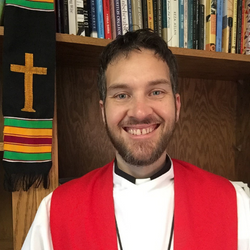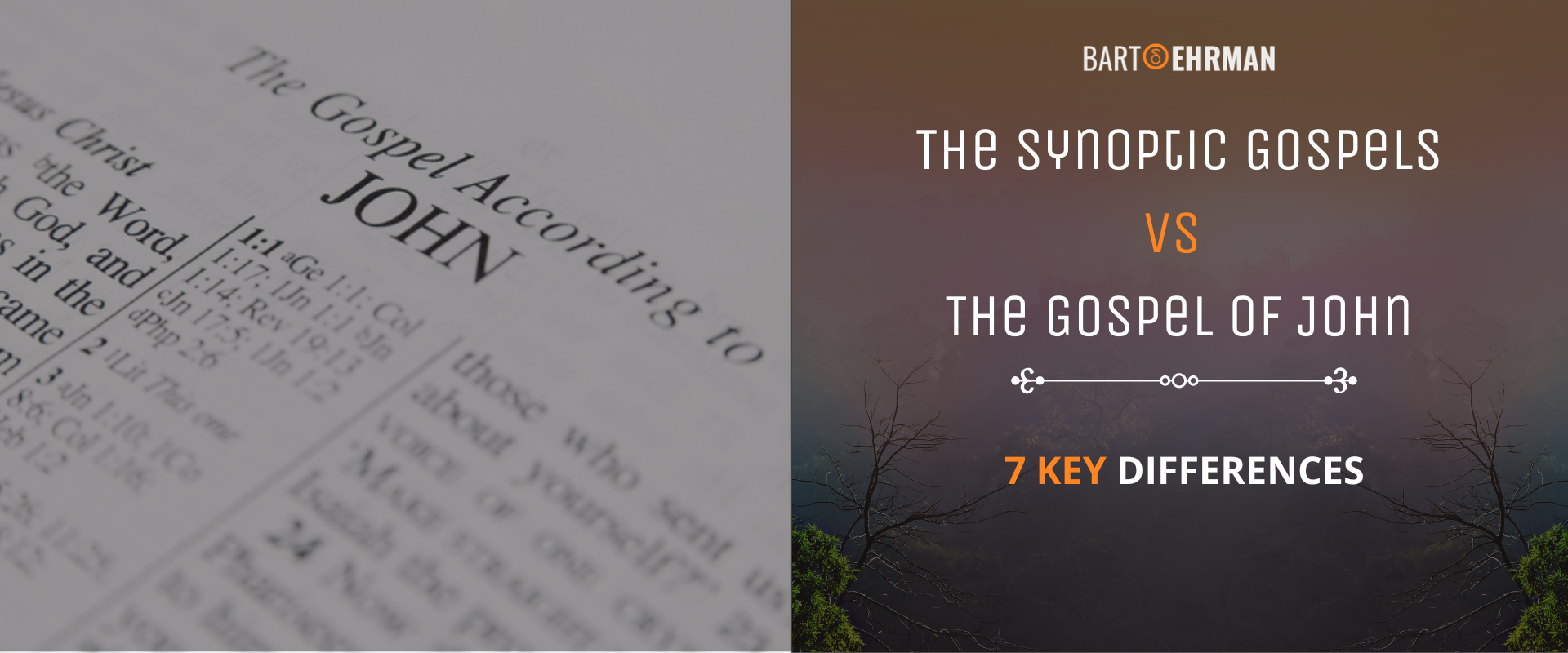The Synoptic Gospels & the Gospel of John: 7 Key Differences

Written by Keith Long, MDiv
Author | Pastor | BE Contributor
Verified! See our editorial guidelines
Verified! See our guidelines
Date written: September 8th, 2022
Disclaimer: The views and opinions expressed in this article belong to the author and do not necessarily match my own. - Dr. Bart D. Ehrman
One of my favorite things to do to pass the time as a kid was flip through a Highlights magazine. Within its pages were several activities intended to sharpen one’s observation and critical-thinking skills. Waiting for the dentist or the doctor was always a breeze when I could spend the time spotting hidden bananas or flamingoes in a picture of a busy market or trying to spot how two seemingly identical pictures differed. The trickery was both exhilarating and maddening as the puzzles could rarely be completed without exercising brain muscles you never knew you had. I credit those activities for stimulating my concentration from a young age until now.

The Synoptic Gospels: Matthew, Mark & Luke
If a person reads the first three Gospels of Matthew, Mark, and Luke (also known as the Synoptic Gospels) back-to-back-to-back according to their order in standard New Testaments not when they were written they will notice how similar each of those three accounts are. Not identical mind you, but very similar.
I doubt anyone tacking on John’s Gospel to that reading would miss how different it is compared to the first three. Readers may think a leaflet got stuck in their Bible by mistake. All four of the New Testament’s Gospels describe the life, death, and resurrection of Jesus Christ. When synthesized together, Matthew, Mark, and Luke provide a stark contrast in a side-by-side comparison to the Gospel of John.
In this article, I explore the seven key differences that set John’s storytelling of Jesus’s life, death, and resurrection apart. You need not worry about concentration headaches! Unlike that impossible-to-find lizard in the corner of a Highlights hidden picture puzzle, the differences in John’s Gospel are glaringly obvious for both casual and informed readers alike.
1. Jesus' Origin Story
At the beginning of John’s Gospel, the starkest difference compared to the other narratives is that there is no regal tale of Jesus’s birth to be found. There is no mention of Jesus’s parents, their long journey to Bethlehem, or Mary’s immaculate conception. There are no angels, no shepherds, no wise men…nothing!
The Gospel of John puts Jesus’s origins much, much, earlier, and elevates his status as far more significant. Even more significant than being conceived by the Holy Spirit as the Synoptic Gospels assert. According to John, Jesus is alluded to be “the Word” and existed before the universe began (Ch 1:1-4).
While the Synoptic Gospels begin Jesus’s story with a miraculous birth—in John’s Gospel, the story of Jesus begins with Jesus and God the creator of the universe on equal footing. In other words, John’s Gospel wants the reader to know from the get-go that Jesus is the Miracle-Maker himself.
Like Mark’s Gospel, the action of John’s story doesn’t spend time describing Jesus’s unusual first days on the earth. Instead, John pulls the curtain back to reveal Jesus as an adult, discussing what’s what with John the Baptist, and immediately recruiting his disciples for the ministry ahead.
2. Jesus’ Teaching
To say that the Synoptic Gospels and John differ regarding Jesus’s teaching style would be an understatement. In Matthew, Mark, and Luke, Jesus is hesitant, afraid even, to speak about himself, his intentions, and his deeds, to anyone. He advises those he heals to tell no one what has happened.
In John, however, Jesus not only embraces talk about his divinity, but he also publicly declares it. In the synoptic Gospels, Jesus speaks in parables (code); In John, the parables are absent altogether and in their place is a Jesus who is very direct about who he is and what he has come to do.
Matthew, Mark, and Luke seem to be on the same page about the coming Kingdom of God, but in John, there is no mention of the coming Kingdom. John focuses readers on Jesus as one being sent by God. The use of metaphor and mystical language is rampant in the Gospel of John whereas the Synoptic Gospels tell stories that sound more historical in nature.
Jesus according to John is a cosmic force in the world, sent by God to love, forgive, and empower people through his presence. The other three Gospels leave much more meaning unpacked as readers are plunged into narratives that are anything but explicit.
3. the Miracles
What John lacks in the frequency of the miraculous in his Gospel, is made up for in the potency of each act. In John, Jesus dazzles in spectacular fashion, unveiling his worthiness in magnificent acts like:
- turning water into wine (Ch 2)
- healing of the lame man by the pool of Bethsaida (Ch 5)
- healing of the man born blind (Ch 9)
- raising of the three-days dead Lazarus (Ch 11)
In addition to his outward demonstrations of power, John’s Jesus also appears to be omniscient. He knows everything about the woman at the well in John chapter 4 and “sees” Nathaneal under the fig tree in chapter 1.
The other three Gospel writers focus the bulk of Jesus’s demonstrations of power on restoring sight to the blind and exorcising the demonic. But amazingly, Jesus never performs an exorcism in John’s Gospel.
Whereas in Matthew, Mark, and Luke, situations seem to spontaneously follow Jesus or crop up wherever he is. In John, it is almost as if Jesus expects situations to develop wherever he is so that he can use those opportunities to glorify God and inspire belief in his divinity.
3. Jesus' Identity
Jesus’s identity in John is dictated early and often, sometimes explicitly—not so in the other three Gospel accounts.
Unlike Matthew, Mark, and Luke, Jesus is open and affirming about his interconnectedness with God. He repeats that trust in him is on par with trusting God and those who believe in Jesus and his words inherit eternal life (14:6; 20:30-31). The concept of eternal life is rarely discussed in the Synoptic Gospels but is an ongoing theme in John’s Gospel.
5. The Passion
In the Synoptic Gospels, multiple chapters reveal the ominous events leading up to Jesus’s crucifixion:
- the institution of the Lord’s supper
- the garden of Gethsemane where Jesus prays for the cup to pass from him
- Jesus’s arrest and trial before the Jewish authorities of the Sanhedrin
Most devout Christians could recite these events by heart—but none of them occur in John’s Gospel. Instead, Jesus spends hundreds of words in spoken prayer captured only by John’s pen. These and other heartfelt and spiritual discourses are unlike anything Jesus says in Matthew, Mark, and Luke.
All four Gospels agree that Judas betrayed the Lord. That said, only in John does Judas bypass the aide of the Sanhedrin bringing “a detachment of soldiers together with police from the chief priests and the Pharisees, and they came there with lanterns and torches and weapons.” (John 18:3)
In Matthew, Mark, and Luke, Jesus’s primary offense is blasphemy, but in John, there is no such verdict made. The Gospel of John is clear Jesus must suffer and die via the Romans because that was why he was born.
6. The Dialogue
Another thing unique to John’s Gospel are the intimate vignettes of Jesus’s rambling, detailed, discourses absent in the other Gospels. John’s Gospel is the only place in the New Testament where Jesus allegedly speaks at great length with:
- Nicodemus (Ch 3)
- the Samaritan woman (Ch 4)
- the disciples (Chapters 13-17)
- Pilate (Chapters 18-19)
- Mary Magdalene and Thomas (Ch 20)
- Peter (Ch 21).
7. The Dialogue
The Gospel of John is also adamant about a character in Jesus’s inner circle known as “the beloved disciple.” This disciple is portrayed as the first to believe, and the one closest to Jesus during his earthly life, as demonstrated by Jesus entrusting his mother into their care at the foot of the cross (Ch 19).
A great deal of speculation and theories have circulated over the years as to the identity of this mysteriously titled disciple. Some believe it is none other than John, son of Zebedee, who is also the author of the Gospel itself.
While other scholarship, such as former Episcopal Bishop and author John Shelby Spong in his book “The Fourth Gospel: Tales of A Jewish Mystic, attest that “the beloved disciple” is Lazarus. The man whom Jesus wept for and raised from the dead. No matter who “the beloved disciple” may or may not be, any mention of that character or phrasing cannot be found anywhere in the Gospels of Matthew, Mark, and Luke.
Conclusion
The potential reasons for these puzzlingly fundamental differences are as vast as the differences themselves. The fantastic and fascinating scholarship of Dr. Bart Ehrman has been a highlight in my ministry and has helped to thoroughly unpack the meaning behind and underneath such confounding ancient documents.
Be it through his many books on the subject or his insights generously shared on his blog – if you seek the Truth that often hides in plain sight, it is time for you to dig into Bart’s scholarship for yourself. If I were you, I’d start with his free webinar “Did Matthew, Mark, Luke, and John Actually Write Matthew, Mark, Luke, and John?”

